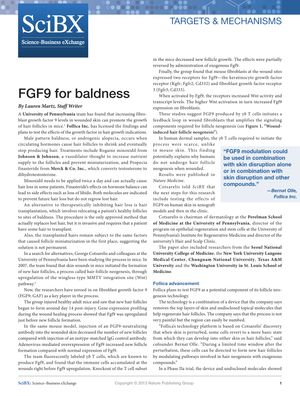FGF9 for Baldness
June 2013
in “
Science-business Exchange
”

TLDR Increasing the levels of a protein called FGF9 can promote hair growth, but humans may not respond the same way due to a lack of certain cells.
In 2013, a team from the University of Pennsylvania discovered that increasing fibroblast growth factor 9 (FGF9) levels in wounded skin could promote the growth of hair follicles in mice. The researchers found that new hair follicles began to form around day 14 post-injury, with Fgf9 upregulated just before new follicle formation. Injections of an FGF9-neutralizing antibody into the wounded skin decreased the number of new follicles, while overexpression of Fgf9 increased new follicle formation. The study also found that FGF9 produced by y8 T cells initiates a feedback loop in wound fibroblasts that amplifies the signaling components required for follicle neogenesis. However, in human dermal samples, the yd T cells required to initiate the process were scarce, potentially explaining why humans do not undergo hair follicle neogenesis when wounded. The findings were licensed by Follica Inc., which planned to test the effects of the growth factor in hair growth indications.




